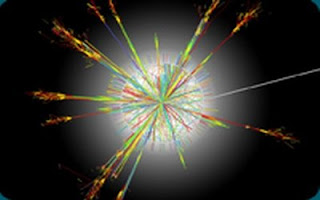
Or almost. Switch on for the Large Hadron Collider at CERN is due to happen on 10 September, 2008, marking the beginning of a physics experiment which intends to recreate conditions last seen a trillionth of a second after the Big Bang.
The experiment involves smashing particles together in a 27 km ring, built 100m underground on the French-Swiss border. Racing at 99.99 per cent of the speed of light, particles will collide at the heart of massive detectors, allowing scientists a fleeting glimpse of tiny subatomic particles which may answer fundamental questions about the building blocks of nature.
As the universe was forming, hadrons bound together to make the larger particles that scientists have been studying since the Greek Democritus coined the term ‘atom’.
We have a relatively clear understanding of some kinds of hadrons like protons and neutrons but many of our universe’s tiniest constituents have yet to reveal their secrets.
One particle which will have theorists sitting on the edge of their seats is the Higgs Boson – if its existence is confirmed then physicists can truly claim to understand the origins of mass: in other words, why some particles are ‘heavier’ than others.
ATLAS is one of the four particle detectors being used to capture images of the fleeting, tiny but very high-energy collisions. ATLAS has been designed to take ‘pictures’ of 600 million proton collisions every second and will be the machine, if physicists are currently correct, that confirms the existence of the Higgs Boson.
Surprises in store
However, other less predictable phenomena are also causing pulses to race as we get closer to switch-on and the day the data from the detectors starts to pour in.
At present, we understand three dimensions: up and down, back and forth, and left and right. Looking into the smallest nooks and crannies of space could reveal extra dimensions, almost unimaginable, which would force us to completely rewrite today’s physics textbooks.
Physicists also hope that the LHC will elucidate some of the mysteries surrounding dark matter. This enigmatic substance makes up the majority of our universe’s mass yet we know very little about it. Physicists have deduced from gravitational effects on visible matter that it’s out there, but only by recreating the conditions present at its birth do we stand a chance of really knowing what it is.
The most exciting findings however are those that cannot yet even be predicted. As Professor Antonio Ereditato, Director of the Laboratory for High Energy Physics in Bern, says, ’This is like opening a window on an unknown view. You expect to see mountains but you may see a sea shore.’
As the LHC steers particles onto a collison course with the equivalent energy of a 400 tonne train travelling at 150 km per hour, the detectors will spew out huge amounts of data. It will then be up to physicists to diligently pore over these results until a mountain, a sea shore or just a very, very Big Bang comes into view.
From : www.physics.org
Converting Spin Waves to Vibrational Waves
2 days ago





No comments:
Post a Comment